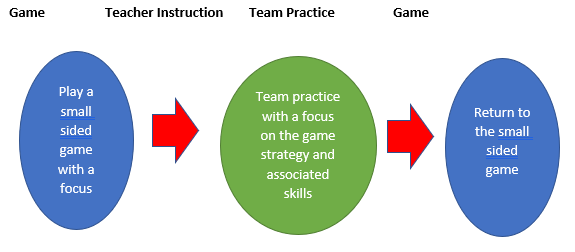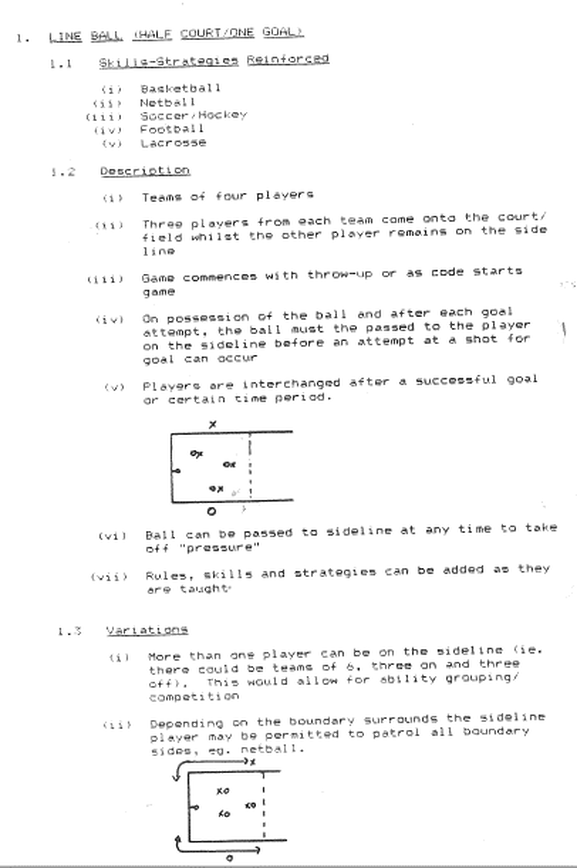By Shane Pill
Associate Professor in Physical Education and Sport at Flinders University, Australia
Website: https://www.flinders.edu.au/people/shane.pill
Twitter: @pilly66
Linkedin: https://www.linkedin.com/in/shane-pill-phd-med-bed-lmachper-fachper-53a3b528/
Orcid: https://orcid.org/0000-0003-3970-6724
Blog: http://learningthroughsport.blogspot.com.au/
Associate Professor in Physical Education and Sport at Flinders University, Australia
Website: https://www.flinders.edu.au/people/shane.pill
Twitter: @pilly66
Linkedin: https://www.linkedin.com/in/shane-pill-phd-med-bed-lmachper-fachper-53a3b528/
Orcid: https://orcid.org/0000-0003-3970-6724
Blog: http://learningthroughsport.blogspot.com.au/
Introduction
To celebrate the 40th anniversary of the Teaching Games for Understanding (TGfU) model, there will be a monthly ‘spotlight’ focus on key models/approaches with the field of Games-Based Approaches (GBAs). To start I would like to provide an outline of Moving Game Approach for the Teaching of Games by Leslie A. House, Edith Cowan University, (1995).
“Games teaching to secondary students needs a strategy that reflects a game context learning environment, high learner involvement levels and participants gaining an understanding of the concepts of game(s). The moving game/game context model for teaching games to secondary students provides such a strategy” (House, 1995, session notes handout)
In 1995, I was teaching at an independent school in Perth and went to a professional development session offered by Les House to explain the Moving game Approach model that he was using with his students at Edith Cowan University (ECU), so we would know what to expect in terms of ECU students understanding of games teaching when they came to us on placement. The Moving Game Approach was explained by Les as a move away from ‘traditional’ development of skill by preference for drill development.
The Lesson Model
The lesson model was game-practice-game. There are a lot of similarities in this lesson flow to the Tactical Approach out of the USA that was beginning to appear in PE literature (e.g., Mitchell et al., 1994).
To celebrate the 40th anniversary of the Teaching Games for Understanding (TGfU) model, there will be a monthly ‘spotlight’ focus on key models/approaches with the field of Games-Based Approaches (GBAs). To start I would like to provide an outline of Moving Game Approach for the Teaching of Games by Leslie A. House, Edith Cowan University, (1995).
“Games teaching to secondary students needs a strategy that reflects a game context learning environment, high learner involvement levels and participants gaining an understanding of the concepts of game(s). The moving game/game context model for teaching games to secondary students provides such a strategy” (House, 1995, session notes handout)
In 1995, I was teaching at an independent school in Perth and went to a professional development session offered by Les House to explain the Moving game Approach model that he was using with his students at Edith Cowan University (ECU), so we would know what to expect in terms of ECU students understanding of games teaching when they came to us on placement. The Moving Game Approach was explained by Les as a move away from ‘traditional’ development of skill by preference for drill development.
The Lesson Model
The lesson model was game-practice-game. There are a lot of similarities in this lesson flow to the Tactical Approach out of the USA that was beginning to appear in PE literature (e.g., Mitchell et al., 1994).
Small-sided Games
Small-sided games were central to the approach. The ‘challenge to pedagogical knowledge of the PE teacher was in knowing how to progress the complexity of the games over time by changing game rules and conditions.
Small-sided games were central to the approach. The ‘challenge to pedagogical knowledge of the PE teacher was in knowing how to progress the complexity of the games over time by changing game rules and conditions.
House (1995) session notes handout
Use of Grids
A grid layout was suggested for the organisation of games. Grid formations were a popular structure for games teaching in the 1980’s, and something that I remember being emphasised in mt PETE training at Teachers College in the mid-1980s.
Competence
Emphasis of the model was on the development of strategic understanding rather than isolated skill development. Drawing on Bunker & Thorpe (1983), Les explained teaching for understanding as three dimensions of learning: When, What and How.
The Curriculum Model
Les suggested the Moving Game Approach be implemented as a curriculum following Rink and Werner (1985) four stages of game skill development:
Stage 1. Object control emphasised
Stage 2. Skill combinations emphasised
Stage 3. Strategic understanding emphasised
Stage 4. Specialised roles emphasised
The Moving Game Approach was never published, unlike other Australian game-based approaches which appear in scholarly and empirical literature: Game Sense (Australian Sports Commission, 1996), Designer Games (Charlesworth, 1994) Play Practice (Launder, 1999: University of South Australia), Play with Purpose (Pill, 2007: Flinders University), Grammar of Games (Forrest, 2019: University of Wollongong), MASTER (Eather et al., 2020: University of Newcastle).
We would like to encourage you to continue supporting the 40th Anniversary of TGfU celebrations; including our next instalment in the special blogs where we will be discussing more limited visibility and/or country-specific models/approaches. Please visit http://www.tgfu.info/40th-anniversary.html for our other events.
A grid layout was suggested for the organisation of games. Grid formations were a popular structure for games teaching in the 1980’s, and something that I remember being emphasised in mt PETE training at Teachers College in the mid-1980s.
Competence
Emphasis of the model was on the development of strategic understanding rather than isolated skill development. Drawing on Bunker & Thorpe (1983), Les explained teaching for understanding as three dimensions of learning: When, What and How.
The Curriculum Model
Les suggested the Moving Game Approach be implemented as a curriculum following Rink and Werner (1985) four stages of game skill development:
Stage 1. Object control emphasised
Stage 2. Skill combinations emphasised
Stage 3. Strategic understanding emphasised
Stage 4. Specialised roles emphasised
The Moving Game Approach was never published, unlike other Australian game-based approaches which appear in scholarly and empirical literature: Game Sense (Australian Sports Commission, 1996), Designer Games (Charlesworth, 1994) Play Practice (Launder, 1999: University of South Australia), Play with Purpose (Pill, 2007: Flinders University), Grammar of Games (Forrest, 2019: University of Wollongong), MASTER (Eather et al., 2020: University of Newcastle).
We would like to encourage you to continue supporting the 40th Anniversary of TGfU celebrations; including our next instalment in the special blogs where we will be discussing more limited visibility and/or country-specific models/approaches. Please visit http://www.tgfu.info/40th-anniversary.html for our other events.
References
Australian Sports Commission. (1996). Game sense: perceptions and actions research report. Canberra: ASC.
Bunker, D, Thorpe, R (1982) A model for the teaching of games in secondary schools. Bulletin of Physical Education 18(1), 5–8.
Charlesworth, R. (1994). Designer games. Sports Coach, 17(4), 30-33.
Eather, N., Miller, A., Jones, B., & Morgan, P. J. (2021). Evaluating the impact of a coach development intervention for improving coaching practices and player outcomes in netball: The MASTER coaching randomized control trial. International Journal of Sports Science & Coaching, 16(3), 439–455.
Forrest, G. (2019). What we do may not be possible/ Transfer of learning and the Grammar of Games. Presentation at the ACHPER International Conference, University of Canberra.
https://www.achper.org.au/documents/item/751
Launder, A. (1999). Play practice: the games approach to t5eaching and coaching sports. Human Kinetics.
Mitchell, S. A., Griffin, L. L., & Oslin, J. L. (1994). Tactical awareness as a developmentally appropriate focus for the teaching of games in elementary and secondary physical education. The Physical Educator, 51(1), 21-28.
Pill, S. (2007). Play with Purpose. ACHPER Publications.
Rink, J., & Werner, P. H. (1985). Teaching physical education for learning. St. Louis: Times Mirror/Mosby College Pub.
Australian Sports Commission. (1996). Game sense: perceptions and actions research report. Canberra: ASC.
Bunker, D, Thorpe, R (1982) A model for the teaching of games in secondary schools. Bulletin of Physical Education 18(1), 5–8.
Charlesworth, R. (1994). Designer games. Sports Coach, 17(4), 30-33.
Eather, N., Miller, A., Jones, B., & Morgan, P. J. (2021). Evaluating the impact of a coach development intervention for improving coaching practices and player outcomes in netball: The MASTER coaching randomized control trial. International Journal of Sports Science & Coaching, 16(3), 439–455.
Forrest, G. (2019). What we do may not be possible/ Transfer of learning and the Grammar of Games. Presentation at the ACHPER International Conference, University of Canberra.
https://www.achper.org.au/documents/item/751
Launder, A. (1999). Play practice: the games approach to t5eaching and coaching sports. Human Kinetics.
Mitchell, S. A., Griffin, L. L., & Oslin, J. L. (1994). Tactical awareness as a developmentally appropriate focus for the teaching of games in elementary and secondary physical education. The Physical Educator, 51(1), 21-28.
Pill, S. (2007). Play with Purpose. ACHPER Publications.
Rink, J., & Werner, P. H. (1985). Teaching physical education for learning. St. Louis: Times Mirror/Mosby College Pub.



 RSS Feed
RSS Feed
